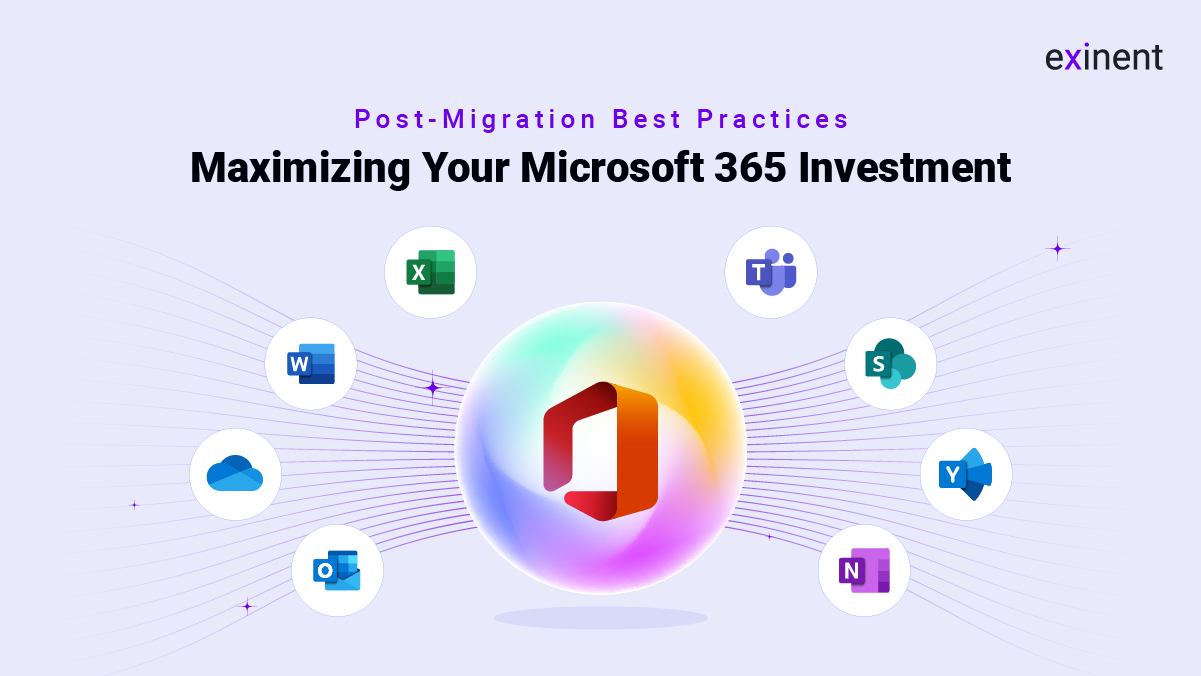
Migrating to Microsoft 365 is a significant step for any organization, offering enhanced collaboration, productivity, and security. However, the migration process is just the beginning. To fully leverage the benefits of your new Microsoft 365 environment, it’s essential to follow post-migration best practices. This blog will guide you through key strategies to ensure you maximize your Microsoft 365 investment, helping you get the most out of your new platform.
1. Evaluate and Optimize Your Microsoft 365 Environment
Once the migration is complete, it’s important to assess how your new environment is performing. Begin by reviewing the setup and configuration of your Microsoft 365 applications and services. Check if all users have the appropriate permissions and if the system is aligned with your organizational needs. Regularly monitor performance metrics and usage statistics to identify areas for optimization.
For instance, ensure that OneDrive and SharePoint are configured to meet your storage needs and that email accounts are set up correctly in Outlook. Optimization may involve adjusting settings or updating policies to improve efficiency and user experience.
2. Provide Comprehensive User Training
User training is crucial for ensuring that employees can effectively use the new tools and features available in Microsoft 365. Even though Microsoft 365 is designed to be user-friendly, its array of features can be overwhelming initially. Offer training sessions and resources to help your team understand how to use Microsoft Teams, OneDrive, SharePoint, and other applications to their full potential.
Consider providing ongoing training and support to address any questions or challenges that arise. Encourage employees to explore the new features and provide feedback on their experience. This approach not only helps in maximizing productivity but also aids in quick adaptation to the new environment.
3. Implement Strong Security Practices
Security is a top priority when managing a Microsoft 365 environment. After migration, review and implement robust security measures to protect your data and ensure compliance. Utilize Microsoft 365’s built-in security features, such as Multi-Factor Authentication (MFA), Conditional Access policies, and Advanced Threat Protection (ATP).
Regularly update your security settings and conduct periodic audits to ensure that they meet industry standards and comply with regulatory requirements. Additionally, educate your staff about best practices for maintaining security, such as recognizing phishing attempts and managing passwords securely.
4. Leverage Collaboration Tools Effectively
One of the key advantages of Microsoft 365 is its suite of collaboration tools. To fully capitalize on this, ensure that your team is using tools like Microsoft Teams and SharePoint effectively. Set up channels and workspaces in Teams for different projects or departments to streamline communication and collaboration.
Encourage employees to use SharePoint for document sharing and collaboration, and make sure that version control and document management practices are well understood. By fostering a culture of collaboration, you can enhance productivity and teamwork within your organization.
5. Monitor and Manage Licenses
Managing Microsoft 365 licenses is essential to optimize costs and ensure that your organization is using its resources efficiently. Regularly review your license usage and adjust based on the needs of your organization. This might involve adding or removing licenses as your team grows or as employees transition between roles.
Utilize Microsoft 365’s administrative tools to track and manage license assignments. This proactive approach helps prevent over-licensing or under-licensing, ensuring that you are only paying for the licenses you actually need.
6. Backup and Recovery Planning
While Microsoft 365 provides robust data protection features, it’s wise to have an additional backup and recovery plan in place. Regularly back up important data to ensure that you can recover it in case of accidental deletion or other issues.
Consider using third-party backup solutions that offer more granular control and recovery options than the native tools provided by Microsoft 365. This additional layer of protection ensures that your data is safe and can be restored quickly if needed.
7. Regularly Review and Update Policies
Post-migration, it’s crucial to review and update your organizational policies to reflect the changes in your IT environment. This includes updating your data retention policies, user access controls, and compliance measures to align with Microsoft 365’s capabilities.
Regularly review these policies to ensure they remain relevant and effective as your organization evolves. Stay informed about new features and updates in Microsoft 365, and adjust your policies accordingly to take advantage of new capabilities.
8. Seek Expert Support from Exinent
Maximizing your Microsoft 365 investment can be complex, and seeking expert support can make a significant difference. Exinent offers comprehensive services to help organizations optimize their Microsoft 365 environments. Our team of experts can provide tailored solutions, from strategic planning to ongoing support, ensuring that your Microsoft 365 deployment is both effective and efficient.
By following these post-migration best practices, you can ensure that your organization fully benefits from its Microsoft 365 investment. From optimizing your environment and providing user training to implementing strong security measures and managing licenses, these strategies will help you make the most of your Microsoft 365 migration. For expert assistance and support, trust Exinent to guide you through every step of your Microsoft 365 journey.
For more information and assistance, visit us at www.exinent.com.
